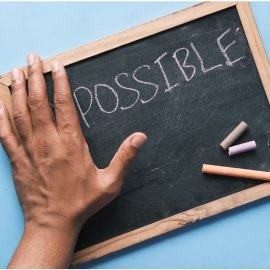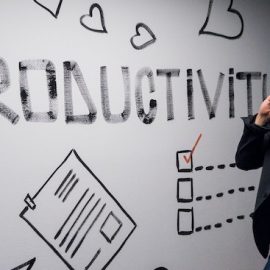

This article gives you a glimpse of what you can learn with Shortform. Shortform has the world’s best guides to 1000+ nonfiction books, plus other resources to help you accelerate your learning.
Want to learn faster and get smarter? Sign up for a free trial here .
Do you believe you’re incapable of growth? What’s the difference between a fixed and a growth mindset?
As you’ve gotten older, you’ve probably discovered certain abilities that you excel at and ones you struggle with. But this doesn’t mean that you’re stuck with what you have. A growth mindset helps you improve by embracing challenges and learning new things.
Let’s look at what a growth mindset is and four ways that developing a growth mindset can be a smooth process for you.
Fixed vs. Growth Mindset
According to Mindset by Carol S. Dweck, you typically live by either a fixed mindset or a growth mindset, which shapes how you learn, cope with setbacks, and relate to others.
When you have a fixed mindset, you believe your abilities are unchangeable. You were born with certain traits and a certain amount of intelligence and that’s that. Many people are trained in this mindset from an early age—for instance, by a teacher who believed your IQ determines everything: You’re either smart or you’re not, and you can learn or you can’t.
When you view your abilities as unchangeable, you feel you must constantly prove yourself. If people get only a set amount of intelligence and a certain character, you want to prove you have a lot, although you secretly worry you were shortchanged. You don’t want to look unintelligent or fail. You feel you’re being judged or rated in every situation and must measure up. Children inculcated with this mindset often fear losing their parents’ or teachers’ approval and love if they fail.
When you have a growth mindset, you believe the abilities you’re born with are a starting point you can build on with hard work, persistence, and the right learning strategies. You have a passion for learning, welcome mistakes as opportunities to learn, and seek challenges so you can stretch. You also have a greater ability to survive difficult times.
The author first encountered the growth mindset as a young researcher while studying how children coped with failure. She gave kids a series of puzzles to solve, progressing from easy to difficult ones. She was surprised to find that some children loved attempting the hard puzzles, relishing the challenge and opportunity to become smarter. Until then, the author had viewed intelligence and problem-solving as fixed abilities, but watching kids learn from failure changed her mind.
Believing in the ability to learn and grow doesn’t mean believing anyone can become an Einstein or believing anyone can do anything they aspire to if they apply enough effort. But the growth mindset recognizes that you can’t predict someone’s potential or how far their passion, work, and learning can take them.
How to Develop a Growth Mindset
It’s important to know that, even if you have a fixed mindset now, you can learn the growth mindset, which can transform many aspects of your life. Below we’ll look at four ways to develop a growth mindset, from admitting you have a fixed mindset to staying hopeful and optimistic.
1. Admit You Have a Fixed Mindset
Often, just learning about the two mindsets and how they affect you can prompt change. However, completely developing a growth mindset takes time. The fixed mindset hangs around, competing with the growth-oriented ways of thinking that you’re trying to adopt.
Your fixed mindset beliefs about being smart, ambitious, superior, and super-competent may be your source of self-esteem. This makes it difficult to give them up for more challenging ideas about developing yourself through effort, taking on challenges, making mistakes, and learning through constructive criticism.
You may temporarily feel that you’re losing your sense of who you are. But the growth mindset ultimately frees you from constantly judging yourself so you can be authentic and explore your full potential.
Developing a growth mindset is a journey. You don’t get there all at once—you have to take one step at a time. The first big step is recognizing that you have a fixed mindset, according to Mindset. Here are the steps to doing so:
1) Accept having a fixed mindset. Even when you’re on a path to growth, you have lingering fixed-mindset beliefs. Everyone has a mix of fixed and growth-oriented beliefs. You can accept this reality without accepting the negatives a fixed mindset causes.
2) Learn what prompts your fixed mindset. When is your fixed-mindset persona likely to materialize? It might be when you take on a challenge, when you face obstacles or fail at something, or when a friend or colleague achieves something you envy.
3) Name your fixed-mindset persona. This can help you identify when you’re acting with a fixed mindset and remind you that’s not who you want to be. Pay attention to what happens with this persona is triggered.
4) Confront your fixed mindset. When your fixed mindset materializes, have an imaginary conversation with it. For instance, if you’re about to take on a new challenge, your fixed-mindset way of thinking may prompt you to worry about failure and want to quit. However, you can be ready to counter these beliefs when they come up by reminding yourself that risk is inherent in growth and that failures are opportunities to learn.
2. Learn From Failure
Mindset drives how people define and cope with failure. For people with a fixed mindset, failure is an identity that they fear and try to avoid rather than something that happens. Failure is hard for growth-minded people, too, but they don’t let it define them.
This is the core of Matthew Syed’s argument about developing a growth mindset in Black Box Thinking: As an individual, you can improve only by learning from your failures. On the flip side, neglecting to learn from mistakes means that you can’t improve. For example, a dancer who takes every mistake as a chance to grow will get better, while a dancer who ignores or denies her errors will remain static.
This also applies on the institutional level: Organizations that learn from failures iron out systemic flaws and improve their performance. Organizations that ignore their mistakes will continue to make them, risking stagnation or worse.
From here, Syed argues that we need to spread failure-based learning throughout modern society. Progress—our ability to develop our knowledge, our societies, or our technology—is a hallmark of human civilization. We develop by learning from failure. But, so long as such major institutions neglect this opportunity, we won’t progress as smoothly.
View Failure as Beneficial
According to Syed, learning from your mistakes starts with changing how you think about failure. By reframing failure as positive and beneficial, you can overcome the fear of erring and start learning from mistakes.
Syed argues that having a fixed mindset correlates with fragile self-esteem. Because failure could reveal your inadequacies, you’ll avoid it for fear of looking foolish or incapable. Regarding failure, people with a fixed mindset are threatened by failure and do everything they can to avoid it because they see it as a reflection of their self-worth.
In contrast, having a growth mindset means you understand that errors are intrinsic to learning. So you’ll regard difficulties, like a challenging work project or struggling relationship, as chances to learn. Regarding failure, people with a growth mindset believe failure is to be expected, and it’s a tool to be used.
3. Seek Feedback
It’s one thing to observe your own mistakes and own up to them, but it’s another for other people to point out your mistakes for you. Sometimes, we put on rose-colored glasses for ourselves. We don’t want to see certain things that need to be improved. That’s why, in their book Thanks for the Feedback, Douglas Stone and Sheila Heen say we need unbiased outsiders to give us feedback to develop a growth mindset.
When seeking feedback, be clear about whether you’re looking for advice, assessment, or appreciation. This will prevent you from getting frustrated or discouraged if you receive the wrong type.
No matter how objective a giver of feedback tries to be, there’s always an inherent element of judgment and interpretation. But, as much as we may value objectivity and strive for it when giving feedback, total objectivity is not actually the goal. Proper judgments and interpretations are what move us forward toward improvement. People who are skilled at giving feedback are valuable precisely because their judgments are sound.
The goal of understanding feedback is not to eliminate judgments but to understand them so that you can discuss them: Why is this more important? Why was that excluded? Is coming in just above projections good, or should you have greatly exceeded it?
The primary difficulty when we receive feedback is that it triggers emotional responses that cloud our judgment and prevent us from properly comprehending the feedback. Gaining control of your emotions involves fully understanding the triggers that produce them.
“Triggers” are instinctive and usually negative knee-jerk responses that can cause you to dismiss feedback or get angry about it. But there are ways to control these triggers so you can apply the feedback and grow as a person: finding your blind spots and looking for differences instead of “wrongs.”
Find Your Blind Spots and Tells
A “blind spot” is something we ignore or attribute little importance to but that other people see clearly. When people give us feedback about a trait we’re blind to, we dismiss it as untrue. Recognizing our blind spots can prevent this. There are different categories of blind spots:
- Emotional distortion: Our emotional reaction to a situation usually seems much more intense to the person on the receiving end than it seems to the person giving the feedback.
- Behavioral patterns: A person often engages in patterns of behavior that she’s unaware of but others around her see clearly.
- Character versus circumstance: When we run into difficulty, we tend to attribute it to the circumstances around us, but other people might blame it on our character.
- Impact versus intent: We judge ourselves by our intentions, but others judge us by how our actions impact them.
- Your “tells”: Your face, voice, and other non-verbal behaviors can betray your true thoughts and emotions.
To become aware of your blind spots:
- Watch for your defensive reactions.
- Look for patterns of feedback that you receive from several sources.
- Record yourself so that you can see any tells you aren’t aware of.
- Get a second opinion if feedback still isn’t sitting right.
Look for Differences and Rights, Not Wrongs
Instead of asking yourself why the feedback is wrong (“That’s not relevant,” “It’s right for you but not for me,” or “You’re not understanding the full context”), acknowledge that you and the other person see things differently, and try to figure out why. By mastering “difference-spotting” in this way, you’ll be able to better understand the other person’s views and move from “No, that’s wrong” to “Tell me more.”
Finally, ask yourself what’s right about the other person’s feedback. Figure out what it is about the feedback that makes sense, what might be worth trying, and how you can find some meaning that might be helpful.
4. Stay Hopeful and Optimistic
In Grit, Angela Duckworth defines hope as the belief that you have the power to improve things.
Duckworth notes that this is a different kind of hope than the hope that says “tomorrow will be better.” Hoping for a better tomorrow is hoping for luck. That type of hope doesn’t contribute to developing a growth mindset because it depends on external factors.
In contrast, the hope that helps you grow is optimism that you can make tomorrow better. This hope—an enduring belief that you can eventually achieve your goals—sustains passion over long periods of time.
She explains that optimists tend to attribute their suffering to temporary and specific causes, while pessimists blame permanent and broad causes. These differing interpretations of the same challenges or setbacks can have significant effects on a person’s motivation.
For example, if a pessimist and an optimist both fail a test, the pessimist is more likely to explain it with permanent, broad causes, like, “I always fail when it matters,” or “I’m bad at math.” These are causes that can’t easily be changed, so the pessimist will more likely believe they simply can’t pass this test and will more likely give up or drop the class.
The optimist is more likely to explain it with specific, temporary causes, like, “I didn’t spend enough time studying these particular concepts.” These types of explanations lend themselves to actionables. Someone attributing failure to these specific causes can work on them so that next time they won’t fail.
Psychologists have found that self-talk like that illustrated above can have an enormous influence on how people view challenges and how they respond to setbacks. This has given rise to the field of cognitive behavioral therapy, which treats depression and other psychological disorders by helping patients think about negative events in healthier, more optimistic ways. The effects of self-talk are so pronounced that this type of therapy has proven more potent and longer-lasting than antidepressant medication.
Wrapping Up
Once you’ve moved past the first stage of admitting you have a fixed mindset, developing a growth mindset is a breeze. On your journey of self-development, just keep in mind that it’s okay to make mistakes, as long as you’re open to learning from them along the way.
What are some other essential tips for developing a growth mindset? Let us know in the comments below!

Want to fast-track your learning? With Shortform, you’ll gain insights you won't find anywhere else .
Here's what you’ll get when you sign up for Shortform :
- Complicated ideas explained in simple and concise ways
- Smart analysis that connects what you’re reading to other key concepts
- Writing with zero fluff because we know how important your time is






